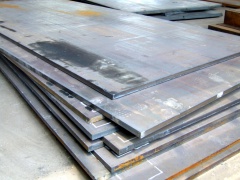Steel plates
| Infobox on Steel plates | |
|---|---|
| Example of Steel plates |  |
| Facts | |
| Origin | - |
| Stowage factor (in m3/t) | 0,48 m3/t (bundles) |
| Humidity / moisture | - |
| Ventilation | - |
| Risk factors | See text |
Steel plates
Description / Shipment / Storage
Sheet metal is metal by an industrial process into thin, flat pieces. It is one of the fundamental forms used in metalworking and it can be cut and bent into a variety of shapes. Countless everyday objects are constructed with sheet metal. Thicknesses can vary significantly, extremely thin thicknesses are considered foil or leaf, and pieces thicker than 6 mm (0.25 inch) are considered plate.
Sheet metal is available in flat pieces or coiled strips. The coils are formed by running a continuous sheet of metal through a roll slitter.
The thickness of sheet metal is commonly specified by a traditional, non-linear measure known as its gauge. The larger the gauge number, the thinner the metal. Commonly used steel sheet metal ranges from 30 gauge to about 8 gauge. Gauge differs between ferrous (iron based) metals and nonferrous metals such as aluminium or copper; copper thickness, for example is measured in ounces (and represents the thickness of 1 ounce of copper rolled out to an area of 1 square foot).
There are many different metals that can be made into sheet metal, such as aluminium, brass, copper, steel, tin, nickel and titanium. For decorative uses, important sheet metals include silver, gold and platinum (platinum sheet metal is also utilized as a catalyst).











